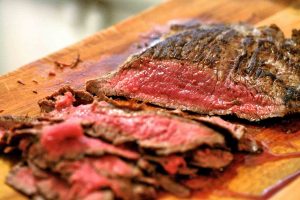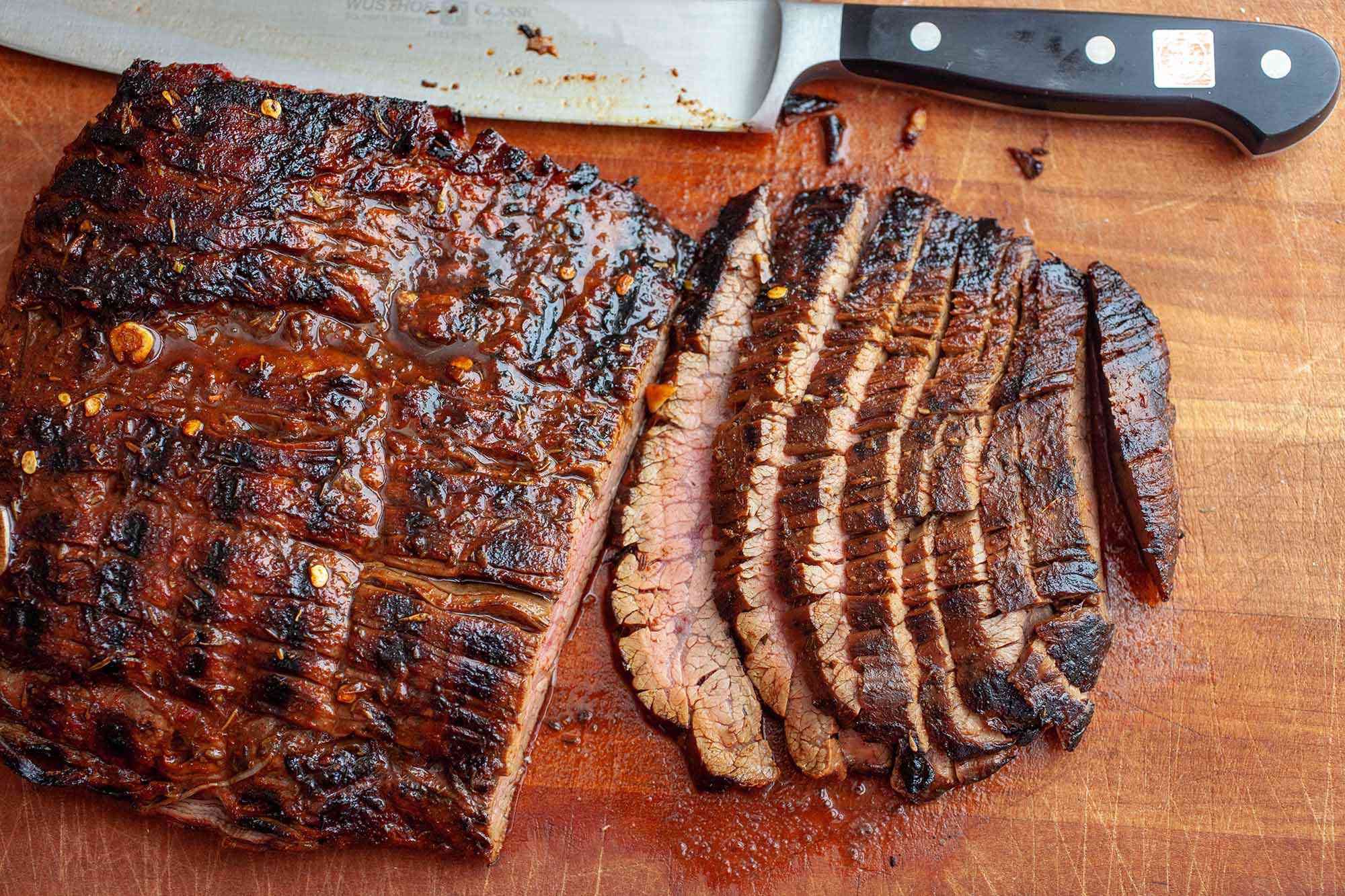In this article, we read about How to cook flank steak?
Flank steak
When adequately prepared, it is incredibly tender and aromatic. The flank steak is lean and usually 2-3cm thick and weighs around 700-1000 grams.
In the USA, it is part of the standard range in almost every supermarket. In this country, it is more challenging to get a good flank steak. The German butchers often do not know the cut, and the flank ends up in the minced meat or sausage. And if you are lucky enough to get aside, it is often tricky because it has not matured long enough. That’s why I swear primarily about US goods that can be bought in the wholesale market (Metro and Handelshof).
But not everyone has the opportunity to shop there. A few online retailers, such as Albers Food, also have flank steak in their range.
Prepare the flank steak properly.
To get a tender and aromatic steak from the “belly flap” of the beef, you should pay attention to a few things.
You should take the meat out of the refrigerator at a good time so that the steak can reach room temperature. I usually put a steak out of the fridge for 2-3 hours before putting it on the grill to cook flank steak. Then you should dodge the meat. Often there is still some fat and thin silver skin on the steak that should be cut away.
To marinate or not? The steak is very suitable for marinating due to its coarse structure with long fibers. The meat is very susceptible to marinades of all kinds. Since I am more of a purist for beef steaks, I usually only season my flank steak with salt and pepper. I think: only inferior meat needs a marinade that covers the meat’s taste. The good heart doesn’t have to be drowned with marinades and sauces.
Do I season the meat before or after grilling?
When I season my steak with salt and pepper, I oil the steak with a heat-resistant oil before grilling and salt it for about 30 minutes before putting it on the grill. The salt supports the meat taste and creates a nice crust. I always season with pepper only after grilling because the pepper burns at high temperatures and becomes bitter.
I usually grill my flank steak spicy and hot so that it gets a few toasted flavors. For this, I use the grill grates, which provide excellent branding. It is well known that the eye also eats with them. If you want to have maximum roast aromas, you can turn the grill grates oven and grill them on the smooth side.
Temperature
After I grilled the flank for about 2-3 minutes over high heat, I put it in the indirect zone and let it steep at about 110-120 degrees C while I was preparing my side dishes simultaneously. In this case, there was caramelized cherry tomatoes and garlic baguette.

Flank steak should generally be grilled medium or medium-rare, then it will be particularly tender. I took it off the grill at a core temperature of 56 degrees C and let it rest for another 1-2 minutes. Tip: To monitor the core temperature, I recommend a thermometer like the Maverick ET-733 too. The resting phase is necessary so that the meat juice can redistribute itself in the steak to cook flank steak. If you cut the flank steak straight away, a large part of the meat juice would come out immediately. Often the tip is given to let the steak rest in aluminum foil, but I advise against that. The steak begins to “sweat” in aluminum foil, and a large part of the meat juice comes out and ends up in the aluminum foil. And we want an incredibly juicy steak, so the rest phase without aluminum foil is recommended.
Bottom Line for Flank Steak
The flank steak has very long fibers. Therefore, it should be cut into thin slices across the grain and served. If you don’t do that, it could be a relatively chew-intensive pleasure. But if you’ve done everything right up to this point and the quality of the meat is good, you should get particularly tender and juicy steak slices. Usually, after slicing, I would add a few more salt flakes and steak pepper over the pieces. But since I seasoned this flank with the molten salt with Tasmanian pepper, I did not strengthen the meat any further.
The seasoning was almost perfect. A pleasant natural salt note and a light pepper taste have wonderfully supported the meat taste of the flank steak and not masked it. The meat quality was also surprisingly good, if not to say great! I’ve never had a “flank” of a German cow that I liked so much. So far, there has been no viable alternative to US beef for my flank steak.
Also read: what should i do



yandanxvurulmus.grFMPlv06CA5
xyandanxvurulmus.RJ8zqTRd4TYV
xbunedirloooo.GvC43SRp6xCu
politicalizing xyandanxvurulmus.k0qWEkd6hPzt
childrens sex wrtgdfgdfgdqq.2Zx3mNilLiN7
seksi siteler wrtgdfgdfgdqq.vmgihqaqWgfi
craft porn pompadirha.S4qK80SIyDWd
amciik siteleri asillartaklitler.ZySCH58VvsGx
porno mobileidn.l6uNMeQtfn40
fuck google 250tldenemebonusuxx.f8sA6dx2RgOG
seks siteleri vvsetohimalxxvc.EYAacf5elRY6
amciik siteleri tthighereduhryyy.kZFHwFgZ0IC
sex video full hd download gghkyogg.daWy4MKogVY
sex 4k videos ggjinnysflogg.NSmQ67waO29
fashionflag xxx video hd porn fashionflag.PeSwgxRvv2o
jenniferroy 混合ポルノ japanesexxporns.vjlzjobHQMt
landuse Vintage porn lancdcuse.NyxVoOQk7tD
falbobrospizzamadison VR porn jkkıjxxx.dDZL77R8FOo
गर्भवती अश्लील qqyyooppxx.z2DnN77sXrk
लैटिन अश्लीलता के बारे में बतावल गइल बा hjkvbasdfzxzz.wvrWp1C3Pvc
व्यभिचारी पति अश्लील txechdyzxca.OR4R8Rhnl1O
समलैंगिक अश्लीलता hkyonet.MlU2QsJ0Qwp
ਮਿਸ਼ਨਰੀ ਸ਼ੈਲੀ ਪੋਰਨ madisonivysex.9ixtqkXtx0q
ladesbet ਗੁਦਾ ਪੋਰਨ ladesinemi.koxIDg1pGgX
c5muhd
ladesbet 老若男女のポルノ ladestinemi.jmTOPKTrph1
4nkjom